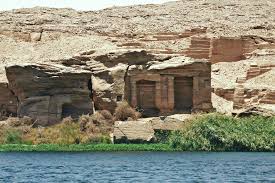Gabal el-Silsilah (Al-Selsela Mountain)
Al-Selsela Mountain is one of the most important archaeological sites in Aswan, located on both the eastern and western banks of the Nile between Edfu and Kom Ombo, about 60 kilometers from the magnificent Temple of Edfu. Its significance comes from its special and unique topographical location at the narrowest part of the Nile Valley, surrounded by sandstone hills on both sides.
West Side and East Side
The west side is called Ramadi Kebli Kode. A Swedish archaeological mission from Lund University worked on a project known as the Gabal Al-Selselah Project in 2012, where an archaeological survey identified and numbered about 104 quarries on each side, which were likely used since the time of the Central State for extracting sandstone.
ChatGPT said:
The importance of these quarries increased during the New Kingdom, gaining great economic and religious significance. The site is divided by the Nile into two sides, East and West, along steep rock faces. Many ancient rock inscriptions, tomb paintings, and stelae exist here.
West Side
There are nearly 33 rock inscriptions dating back to the 18th Dynasty carved into the cliffs, and these are considered among the earliest from the 19th Dynasty. At the northern end of the west side, structures built by Merneptah, Ramses II, and Seti I can be found.
East Side
The east side contains the most fascinating quarries from the New Kingdom, especially from the time of Ramses II. One text mentions that 3,000 workers were employed to transport stones from the Al-Selsela Mountains to build the Ramseum temple. There are many stelae, funerary paintings, and statues of unfinished sphinxes. Ramses II also carved statues and several tombs into the rocks. Although Ramses II built a temple there, it was completely destroyed. Rock paintings and inscriptions from Bibi I and Abis Wa’ib Ra have also been found.
Recent Discoveries
The harbor used to transport stones from the Al-Selsela quarries across the Nile was recently discovered on the east bank, stretching about 100 meters. It had previously been covered by dust and Nile silt.
Additionally, the Swedish-Egyptian mission involved in discovering new tombs and numerous rock inscriptions that have altered the understanding of the site found inscriptions dating from the Paleolithic, Neolithic, and Predynastic periods, as well as inscriptions from Greek and Roman families. These inscriptions include some Coptic writings, hunting scenes with human figures, chased animals, and giraffes.

